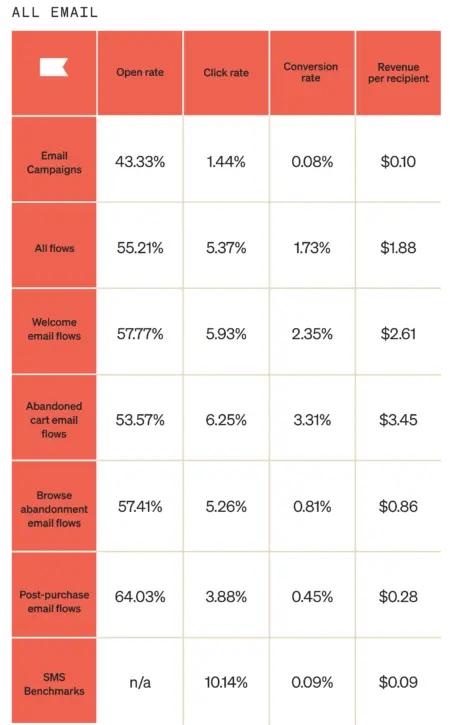An email list is your best brand investment. Here are the return per recipient metrics to prove it.
An email list is an owned channel—and no algorithm switch-up can take it away from you.
Yet so many marketers still struggle to justify the importance of email marketing to leadership teams that may want to make sexier investments at the expense of tried-and-true results.
Email marketing isn’t shiny, but it still works because it only happens when someone gives your brand explicit permission to access their inbox.
It’s this respectful permission, so rarely found in our digital lives, that grows businesses.
Just take a look at Klaviyo’s latest email benchmarks by industry, collected from over 130K paying Klaviyo customers:

Whether you’re struggling to explain the importance of email to a newbie or just need a refresher on how you can see higher ROI with email, you’ll leave this article with a complete vocabulary on how this fundamental marketing channel can drive revenue for your business.
The revenue metrics to anticipate from basic email automations
As you become more skilled and sophisticated with email, you’ll come to know what success looks like for your email campaigns and your email automations. But if you need some benchmarks to make a case for building an email list, you’ve come to the right place.
Here’s a quick overview of the purpose of some basic email automations and benchmarks for each, based on data from over 100K paying Klaviyo customers:
1. Welcome series emails.
A welcome email series is a controlled introduction to your brand after someone finds it via their own means.
Use your welcome series to give people a first look at your brand story, introduce your best products, and incentivize people to continue engaging with your brand.
Welcome series benchmarks
- Average click rate: 5.93%
- Average conversion rate: 2.35%
- Revenue per recipient: $2.61
7 ways your welcome series contributes to growth
- Encourages a purchase through a discount code
- Introduces new and featured products to a fresh audience
- Gathers additional zero- and first-party customer data for segmented campaigns
- Drives website traffic back to your online store
- Expands owned channel audience via requests to forward
- Extends social media reach via requests to follow
- Builds brand trust that can translate to word of mouth
2. Abandoned cart emails.
An abandoned cart email goes out after someone places an item in their cart on your website but doesn’t complete the purchase.
Use your abandoned cart email to nudge people toward completing their purchase. You can also feature similar or alternative products to encourage a purchase that might work better.
Abandoned cart benchmarks
According to Klaviyo’s latest email benchmarks by industry, abandoned cart emails earn the highest engagement rates on every relevant metric:
- Average click rate: 6.25%
- Average conversion rate: 3.31%
- Revenue per recipient: $3.45
5 ways your abandoned cart email contributes to growth
- Transforms abandoned purchases into completed purchases
- Gathers zero- and first-party customer data on product preferences
- Introduces similar or alternative products to an engaged audience
- Creates a new email segment of people who are close to buying
- Drives traffic back to your website for possible purchasing
3. Browse abandonment emails.
A browse abandonment email goes out when someone views a product page on your website but leaves before adding an item to their cart.
Use your browse abandonment email subject lines to nudge people toward starting and completing a purchase. Here’s where you can drive people back to your website so they can dive deeper down their education rabbit hole, which is likely what they need most at this stage of the buying journey.
Browse abandonment email benchmarks
- Average click rate: 5.26%
- Average conversion rate: 0.81%
- Revenue per recipient: $0.86
5 ways your browse abandonment email contributes to growth
- Drives traffic back to your website for more education, leading to a purchase
- Gathers zero- and first-party customer data on product preferences
- Introduces similar or alternative products to an engaged audience
- Creates a new email segment of people who need more information before buying
- Keeps your brand top of mind as people compare your product to other brands
4. Post-purchase emails.
A post-purchase email goes out after your customer buys something. A post-purchase email series can be two things: it’s either a collection of transactional emails, which might include shipping and delivery confirmations, or educational/marketing emails, such as assembly and maintenance instructions or up-sell promotions that encourage more buying.
Use your post-purchase emails to build trust and brand loyalty by communicating basic information like shipping dates and return policies.
If you want to use your post-purchase emails to up- and cross-sell, just be careful not to mix them into your transactional emails if your customers are in Europe—it’s a violation of GDPR. In the U.S., you’re allowed to do this as long as the primary purpose of the email is transactional.
Post-purchase email benchmarks
- Average click rate: 3.88%
- Average conversion rate: 0.45%
- Revenue per recipient: $0.28
7 ways your post-purchase email contributes to growth
- Reinforces a good relationship with your customers
- Gathers zero- and first-party customer data on buying habits
- Lays the groundwork for retention marketing strategies
- Creates a new email segment of people who may purchase again
- Expands your list of positive reviews
- Stimulates word of mouth and email list growth through forwarding
- Grows your loyalty program, if you have one
5 crucial yet overlooked email list building best practices
Some fundamental aspects of email list building are regulated by governments, so it’s important to know what you’re allowed to do before you begin.
1. Compliance: the backbone of consent-based marketing.
In the US, the CAN-SPAM Act governs commercial email and gives people the right to opt out and unsubscribe from your email communications at any time. In Canada, CASL lays out similar rules and consumer protections.
But since it’s the most aggressive privacy and security law in the world, most brands adhere to the EU’s General Data Protection Regulation (GDPR).
GDPR compliance is an article in and of itself (one we’ve written), but the basics are:
- People have the right to know how their data is collected and why.
- When someone asks, you must delete all the data you have about that person.
- You’re only allowed to collect personal data from people who have given you explicit consent.
- You need to add consent checkboxes to any sign-up forms that don’t clearly state what people are signing up for and why you need their information.
- When someone subscribes to your email list, use double opt-in by asking them to confirm their subscription via email before adding them to your list.
- All emails need an obvious unsubscribe link, and it needs to be easy to unsubscribe.
2. Before we move on: never, ever buy an email list.
Whether you own your brand or run email marketing campaigns for one, at some point you may receive an offer to purchase an email list.
Don’t bite.
First, emailing people from a list you purchase is illegal because those contacts didn’t give you explicit consent to email them.
Second, a purchased list is a low-quality one. You’ll be emailing people who have never heard of your brand because they didn’t discover it on their own.
In addition:
- Your email deliverability will suffer.
- Your engagement rates will plummet.
- Your unsubscribe rates will jump through the roof.
Email marketing, and consent-based marketing in general, is about patience and respect. Preserve brand integrity. Never buy an email list.
3. Periodically clean your email list.
Some inbox providers, like Gmail, learn to filter emails into the spam folder based on whether or not an individual typically opens emails from this sender. That means frequently emailing subscribers who aren’t opening your emails increases your risk of being marked as spam.
About twice a year, you should create a segment of subscribers who haven’t opened your emails within 6 months or made a purchase. Remove these inactive subscribers from your active mailing list—and then give them special attention. Try using a win-back email flow to re-engage these subscribers.
4. Remove suppressed subscribers from your segments.
Suppressed subscribers are subscribers who have unsubscribed or hard bounced, usually because their email address is invalid. In every segment you send to, you should have a condition that removes suppressed contacts.
While intelligent marketing automation platforms like Klaviyo protect you from the risk of spam complaints by not sending to suppressed contacts, not all ESPs do this. Removing suppressed subscribers from your segments will give you a more accurate headcount of who�’s getting your emails, which can help you strategize both your messaging and growing your list.
5. Use folders to keep your lists and segments organized.
Organize segments and sub-segments into folders based on their purpose. For example, you may have:
- A master newsletter list
- A main newsletter segment that excludes your suppressed subscribers
- A daily newsletter segment based on your subscribers’ preferences
As you become more sophisticated in your email marketing strategy, you’ll start to accumulate a large number of lists and segments. Some may be one-time segments that you only send one campaign to, but odds are you reuse the same few segments frequently.
Email list management best practices FAQs
What are best practices for email list management?
Clean your email list every few months, remove suppressed subscribers from your segments, and use folders to keep your lists and segments organized.
How often should you update your email list?
Update your email list twice a year by creating a segment of subscribers who either haven’t opened your emails within 6 months, or haven’t made a purchase. Remove these inactive subscribers from your active mailing list, but first try using a win-back email flow to re-engage them.
How should I categorize my emails?
Categorize your email list by creating segments based on factors like online behavior, lifestyle, and demographics. When you target recipients based on behaviors like purchase history, website browsing, marketing engagement, etc., you can more easily send relevant messages that will increase the likelihood of a conversion or more engagement.
Read more from Klaviyo’s Approach:
- Average email open rates: How to interpret and improve your data
- 6 ways to reduce email bounce rates
- Proof that personalized emails outperform blasts


Related content

Celebrate the Festival of Lights with 7 Hanukkah marketing ideas to boost sales, engage customers, and honor tradition through quizzes, gifts, and giving back.

Unlock the power of customer journey mapping to boost email revenue. See how mapping every touchpoint builds loyalty, retention, and lasting growth.

Gmail’s new updates are here: see what changed, why it matters, and how marketers can adapt ahead of BFCM.